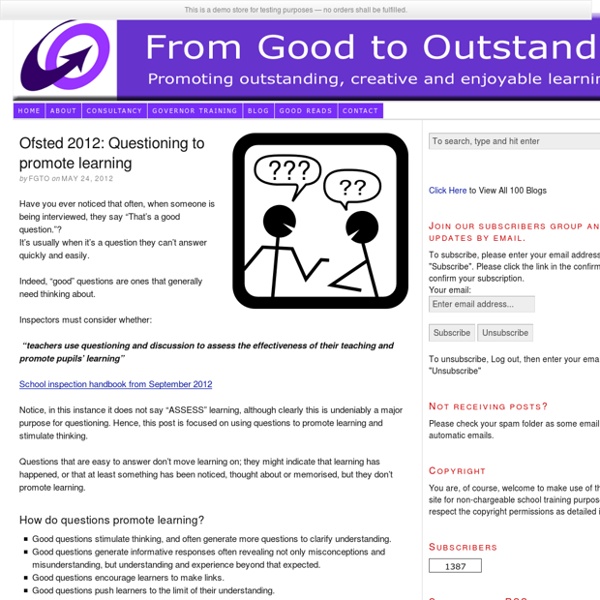Ofsted 2012: Questioning to promote learning — From Good to Outstanding

How The Memory Works In Learning
How The Memory Works In Learning By Dr. Judy Willis, M.D., M.Ed. Teachers are the caretakers of the development of students’ highest brain during the years of its most extensive changes. As such, they have the privilege and opportunity to influence the quality and quantity of neuronal and connective pathways so all children leave school with their brains optimized for future success. This introduction to the basics of the neuroscience of learning includes information that should be included in all teacher education programs. Teaching Grows Brain Cells IQ is not fixed at birth and brain development and intelligence are “plastic” in that internal and environmental stimuli constantly change the structure and function of neurons and their connections. It was once believed that brain cell growth stops after age twenty. High Stress Restricts Brain Processing to the Survival State Memory is Constructed and Stored by Patterning Memory is Sustained by Use The Future References Ashby, C.
Differentiated Instruction Resources
Home | Global Digital Citizen Foundation
Mnemonic Dictionary - Fun and easy way to build your vocabulary!
Augmented Reality in English Language learning | ELT MATERIALS
I recently attended Interfacing with Public Space: Embodied language learning with mobile technologies a workshop delivered by Paul Driver who is an educational technologist and co-author of Language Learning with Digital Video series. During the workshop I got introduced with a free augmented reality application Aurasma and how it is used to create and design learning materials for classes. Augmented Reality (AR) is defined as ”a variation of Virtual Environments (VE), which allows the user to see the real world, with virtual objects superimposed upon or composited with the real world.” AR-based mobile learning material helps engage learners in numerous learning activities. For example, Liu & Tsai (2013) investigated the use of augmented reality materials to develop writing skills in EFL classes. they used global positioning and AR techniques. The students were asked to introduce their campus. ( The above picture is taken from Liu & Tsai study: shows the AR application) References
Cool Tools for School | Its all about the learning!
Learning First, Technology Second The Educator’s Guide to Designing Authentic Lessons By Liz Kolb
By Liz Kolb Learning with technology doesn’t happen because a specific tool “revolutionizes” education. It happens when proven teaching strategies intersect with technology tools, and yet it’s not uncommon for teachers to use a tool because it’s “fun” or because the developer promises it will help students learn. Learning First, Technology Second offers teachers the professional learning they need to move from arbitrary uses of technology in their classrooms to thoughtful ways of adding value to student learning. This book includes: About the Author Liz Kolb is a clinical assistant professor at the University of Michigan. Media Reviews Kolb’s Triple E Framework is an excellent tool for helping teachers focus on using technology to support learning and not just using technology for its own sake.
Why Schools Should Be Wary Of Free Tech Products -- And Startups Shouldn't Make Them
When I was a middle school science teacher, I oftentimes found myself digging into my own pockets to pay for equipment — Bunsen burners, test tubes, dead frogs. And that didn’t change when one-to-one iPad programs in schools became popular; in fact, it added yet another item, software, to my to-buy list. So, you can imagine my excitement when I found free online products, especially those that seemed flashy. It didn’t even cross my mind back then that using free tools (and more importantly, asking my students to use free tools) could be problematic and even potentially dangerous — more so than the free consumer products I was finding online and using in my own time. But in the world of edtech, “free” isn’t only a danger to the users — it’s quickly becoming more and more of a danger to the makers of edtech, as well. To the users: Nothing is really free There really is no so thing as a free education technology product for the user — because what's more valuable than money?
Related:
Related:



